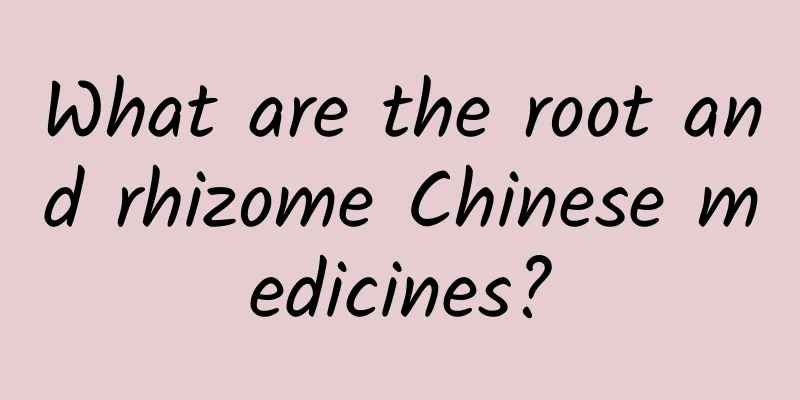What are the root and rhizome Chinese medicines?

|
There are many types and sources of Chinese medicine. Various plants and animals can be used as medicine. Things like ants, insect eggs, mugwort, and dogtail grass can all be added to traditional Chinese medicine. We all admire the wisdom of the ancients, as they were the first to experiment. We not only study the plants growing on the soil, but also wonder what functions their roots have. Now let me talk about what Chinese medicines are there for roots and rhizomes. The root and rhizome medicinal materials are basically as follows: Panax notoginseng: It is the root of Panax notoginseng, a plant of the Araliaceae family. Product specifications: main roots are divided into 60 heads, 80 heads, 120 heads, and countless heads. The base of the stem is called the cut; the branch roots are called tendons; the thinner roots are called velvet roots. Dead radish: the old root of radish, a plant of the cruciferous family. Prescription alias: withered radish, air radish, immortal bone, immortal head, ground skull, ground withered radish, empty radish, old man's head White aconite root: the tuber of the Araceae plant, Aconitum carmichaelii. Prescription alias: white aconite, processed white aconite, Yu white aconite, salt aconite, unicorn lotus, white wave string, milk white aconite, chicken heart white aconite Ganoderma lucidum seeds: the tuberous root of the Ganoderma lucidum plant of the Ranunculaceae family. Prescription alias: Tiankui, Tiankui seeds, Tianquzi, Tiankui root, purple-backed Tiankui seeds, Xia Wuzong, Liangtoujian, Qiannian rat feces Stephania tetrandra: It is the root of the Stephania tetrandra plant of the Menispermaceae family. Prescription alias: Powdered Fangji, Han Fangji, Fangji, Powdered Cunji, Dissociation, Stone Dissociation, Stone Toad Belamcanda chinensis: It is the rhizome of the Belamcanda chinensis plant of the Iridaceae family. Prescription alias: Shegan, Cun Gan, Bianzhu, Bianzhulan, Guishan, Laojunshan, Kaikoujian, Wupu, Huangyuan Dioscorea zingiberensis: The rhizome of Dioscorea zingiberensis of the Dioscoreaceae family. Prescription alias: Chuanshanlong, Chuandilong, Chuanshanlong Polygonum multiflorum: It is the tuberous root of the Polygonum multiflorum plant of the Polygonaceae family. Prescription alias: Polygonum multiflorum, Polygonum multiflorum, processed Polygonum multiflorum, goblin, night-blooming jasmine, red kudzu, red astringent, red internal elimination, Jiuzhenteng, horse liver stone, mountain slave, mountain brother, mountain old man Well, the editor has already introduced in a relatively comprehensive manner what Chinese medicinal roots and rhizomes are there. I wonder if my explanation has really helped you? The flowers and seeds of some plants have medicinal value, and the rhizomes and roots of some plants have medicinal value. So, don't ignore the value of every part of the plant. A full understanding of these can help us prevent and cure diseases. |
<<: What are the medicinal properties of Poria cocos?
>>: What are the medicinal properties of Saposhnikovia divaricata?
Recommend
The efficacy and function of rock henna
Traditional Chinese medicine requires the use of ...
Eating too much for a long time is more harmful to your body than you think (not just getting fat)
We all have times when we eat too much. I usually...
The efficacy and function of three core grass
Speaking of herb, many people know that it is a t...
The "Beijing Man" who disappeared in the war tells us the value of peace
Beijing is a city with a history of more than 3,0...
The efficacy and function of Dasin
Although Western medicine and Western drugs are m...
State Post Bureau: China's express delivery business volume will exceed 100 billion pieces in 2022
At 8:10 a.m. on December 1, real-time monitoring ...
Local temperature drops by more than 10℃! A new wave of cold air is coming
The Central Meteorological Observatory predicts t...
Really? The meat we eat in the future may not necessarily come from living animals!
□ Shan Shouqing The steamed buns invented by Zhug...
The flower market has many tricks, let’s fight against counterfeiting together!
Among all major commodity categories, flowers and...
The efficacy and function of camel thorn
Camel thorn is a common Chinese medicine with man...
Cherish the time! Big data tells you that autumn is getting shorter in these places
Entering the Autumnal Equinox, most of northern m...
The efficacy and function of Niuziqi
Do you know Niuziqi? It is a common Chinese medic...
Should I take medicine before or after meals? Do I need to take my medicine if I forget to take it? Many people do this wrong...
Experts in this article: Wang Wei, Deputy Directo...
Stop eating like a glutton! These types of people should pay special attention →
Review expert: Wang Xuejiang, professor at Capita...









